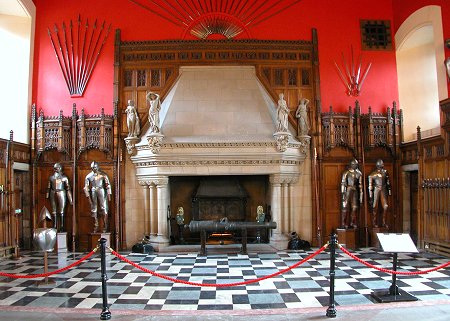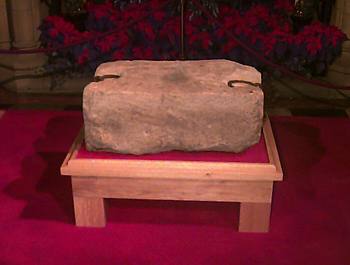Another absolutely gorgeous day in Scotland. The locals can't believe it.
We found out that the last tender was at 2:30 am, glad we made it in early!
Another day to explore Edinburgh! Since we had not been inside the Edinburgh Castle yet, we started there in hopes of beating some of the crowds. Just to make sure, we bought advance tickets. Edinburgh Castle is situated high on a rock, actually on an extinct volcano.
Imagecredit:https://media-cdn.tripadvisor.com/media/photo-s/06/99/dd/7b/princes-street-gardens.jpg
Imagecredit:http://www.undiscoveredscotland.co.uk/edinburgh/edinburghcastle/images/upper-fireplace-450.jpg
The castle was a royal residence until the early 1600s. Research shows that over its 1100 year history, the castle saw 26 sieges, making it the most attacked place in Great Britain. The castle last saw military action in 1745. After that it was a prison from 1757 until 1814 (when 49 prisoners of war escaped!) and an army base until the 1920s. It was also a prison during both World Wars.Mons Meg is a siege cannon from 1449. It was fired in 1558 to celebrate the wedding of Mary Queen of Scots, and the 150 kg cannon ball was found over 3 kilometers away. It was last fired in 1681 on the Duke of Albany's birthday, and the barrel burst open.
In 1650, Oliver Cromwell besieged the castle. The Honours of Scotland (Crown, Sword, and Sceptre) were buried at a distant church so that Cromwell could not get his hands on them. Sir Walter Scott rediscovered them in 1818. They were hidden again during WWII in case of German occupation. You can now see the Honours of Scotland in the Crown Room:
We also saw the Stone of Scone, or the Stone of Destiny. This is a rock of yellow sandstone that weighs 336 lbs. It was used to crown Scottish kings until Edward I invaded Scotland and took the stone to London. It became part of the Coronation Chair at Westminster Abbey, to symbolize the rule of English kings over Scotland.

Imagecredit:http://www.educationscotland.gov.uk/Images/CoronationChair%20and%20StoneofDestiny%20L_tcm4-562048.jpg
Unless the fates be faulty grown
And prophet’s voice be vain
Where’er is found this sacred stone
The Scottish race shall reign.
And prophet’s voice be vain
Where’er is found this sacred stone
The Scottish race shall reign.
This legend was fulfilled when King James became both King of Scotland and King of England. The stone was last used in 1953 for the coronation of Queen Elizabeth II. In 1996, the stone was returned to Scotland by the British government.
We found a curbside just below the castle, on the Royal Mile, and snacked on some food we had brought, while listening to a busker piper. Where else in the world could you do that?
We walked all the way down the Royal Mile, which was full of buskers. In the space of 2 minutes, we saw a mermaid, Minnie Mouse, Darth Vader, and Harry Potter. Quite fun.
We eventually got down to the Holyroodhouse Palace, built in the 1500s. This has been the official Royal Residence since the 16th century. It is open to tourists whenever the Royal family is not staying here. Our ticket came with a free audio tour that explained everything room by room:
Imagecredit:http://www.everycastle.com/images/Holyrood%20Palace%201.jpg
It was here in 1566 that Mary's jealous husband Darnley used the private stairs to enter the queen's apartments, grab her secretary David Rizzio, and stab him 56 times.
To celebrate Queen Elizabeth's 90th birthday, there is an exhibition on her wardrobe.
It was here in 1566 that Mary's jealous husband Darnley used the private stairs to enter the queen's apartments, grab her secretary David Rizzio, and stab him 56 times.
Imagecredit:http://madameguillotine.org.uk/wp-content/uploads/2012/11/QueenMaryBedroom.jpeg
To celebrate Queen Elizabeth's 90th birthday, there is an exhibition on her wardrobe.
Imagecredit:http://i.telegraph.co.uk/multimedia/archive/03567/Queen_Elizabeth_II_3567793k.jpg
We had a peaceful walk through the Holyrood Palace Gardens:
We grabbed a taxi to the Edinburgh Botanic Gardens, established in 1670. It is over 70 acres large and has over 15,000 plants. It was free except for the greenhouses. The 10 greenhouses were all connected and very nice to walk through, although Anton complained about the humidity.
We decided to call it a day around 4 pm, we were both tired, and we wanted to eat on the ship where Ernan and Lucia take such excellent care of us. By the time we got a taxi to the dock and then were tendered in, it was 5 pm.
















No comments:
Post a Comment